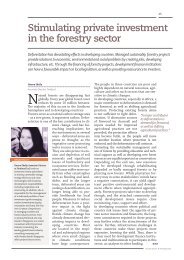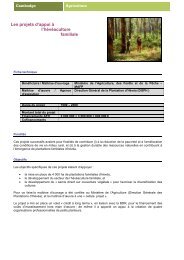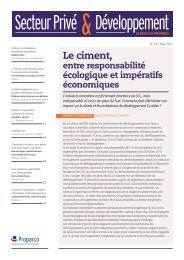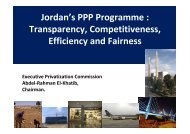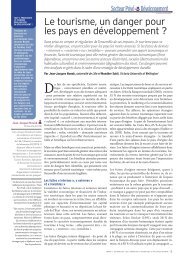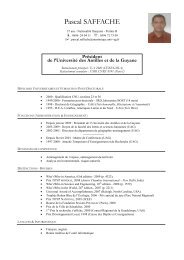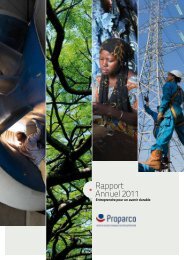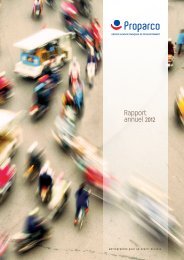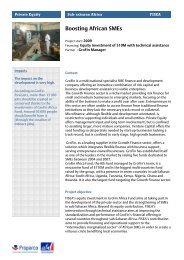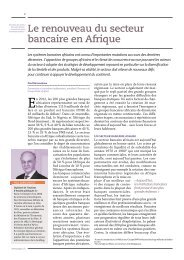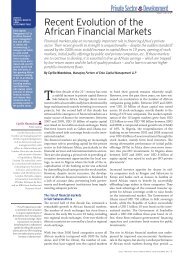Integrating Poor Populations in South African Cities - Agence ...
Integrating Poor Populations in South African Cities - Agence ...
Integrating Poor Populations in South African Cities - Agence ...
Create successful ePaper yourself
Turn your PDF publications into a flip-book with our unique Google optimized e-Paper software.
Abstract<br />
In <strong>South</strong> Africa, urban development issues are essential, especially for the urban<br />
<strong>in</strong>tegration of underprivileged households and settlements <strong>in</strong> the ma<strong>in</strong> cities. The spatial<br />
segregation imposed by apartheid fragmented the urban environment and spatially<br />
excluded non-white people from cities. S<strong>in</strong>ce 1994, the post-apartheid government,<br />
led by the <strong>African</strong> National Congress (ANC), has developed catch-up policies for<br />
historically disadvantaged groups, ma<strong>in</strong>ly <strong>in</strong> regard to service delivery: free s<strong>in</strong>glefamily<br />
houses, water, electricity. These policies have had considerable results, but the<br />
houses have mostly been built at city fr<strong>in</strong>ges, which has not made it possible to spatially<br />
<strong>in</strong>tegrate these populations <strong>in</strong> cities. Because spatial plann<strong>in</strong>g was used to establish<br />
apartheid, plann<strong>in</strong>g <strong>in</strong>struments — both forward plann<strong>in</strong>g and regulatory processes<br />
— are not used by public authorities to conceive urban development. This is one of the<br />
ma<strong>in</strong> h<strong>in</strong>drances to <strong>in</strong>tegration. In addition, the production of urban areas for struggl<strong>in</strong>g<br />
populations is today heavily guided by the construction of hous<strong>in</strong>g — essentially<br />
small, s<strong>in</strong>gle-family houses located <strong>in</strong> remote areas — and not coord<strong>in</strong>ated with other<br />
urban functions. Other options, such as rental hous<strong>in</strong>g and the <strong>in</strong>-situ upgrad<strong>in</strong>g of<br />
<strong>in</strong>formal settlements, are progressively be<strong>in</strong>g developed <strong>in</strong> order to diversify the public<br />
hous<strong>in</strong>g supply. This hous<strong>in</strong>g-based approach does not generate <strong>in</strong>tegrated settlements,<br />
and cities do not yet seem able to manage their urban development strategically, nor<br />
do they seem able to <strong>in</strong>tegrate poor households. However, all government spheres seem<br />
to be <strong>in</strong>creas<strong>in</strong>gly aware that it is both relevant and crucial to th<strong>in</strong>k about urban issues<br />
<strong>in</strong> terms of the liv<strong>in</strong>g environment. Many <strong>in</strong>novative projects are emerg<strong>in</strong>g that take <strong>in</strong>to<br />
account exist<strong>in</strong>g settlements and seek to produce suitable human settlements for<br />
disadvantaged groups. This territorial approach, which relies on overall management<br />
of the urban project, is still experimental and deserves close attention.<br />
5<br />
Keywords: public policies, cities, <strong>in</strong>tegration, urban development, disadvantaged<br />
populations, urban plann<strong>in</strong>g, hous<strong>in</strong>g, public authorities, municipalities, urban projects.<br />
© AFD 2009 <strong>Integrat<strong>in</strong>g</strong> <strong>Poor</strong> <strong>Populations</strong> <strong>in</strong> <strong>South</strong> <strong>African</strong> <strong>Cities</strong>



